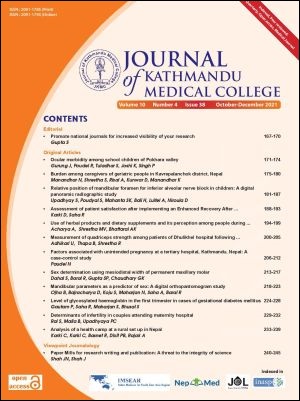Use of herbal products and dietary supplements and its perception among people during the COVID-19 pandemic
DOI:
https://doi.org/10.3126/jkmc.v10i4.43860Keywords:
Coronavirus disease-2019, Nepal, PerceptionAbstract
Background: In Nepal herbal medicines are popular and are used along with or instead of allopathic medicines. Scarcity of efficient and new pharmacological treatment and vaccine for COVID-19 has made people find alternative ways to prevent or treat the disease, including measures like use of herbal products. Evidence-based use of herbal products should be implemented to ensure patient safety.
Objectives: To determine the prevalence of use of herbal products during COVID-19 and to find patients perception regarding their use.
Methods: A descriptive online cross-sectional study was conducted among adult Nepali population from 5th February to 6th June 2021 after ethical clearance at Kathmandu Medical College. Convenience sampling was used to request 292 adults who could be traced through social media, living in Nepal, one member from one household were included. Participants unable to respond to English were excluded. Questionnaires consisting of socio-demographic characteristics, use of herbal products, Likert scale to measure perception was used. Data were transferred into Excel sheet and exported to SPSS v.20 for analysis.
Results: Prevalence of use of herbal products during COVID-19 was 206 (70.5%). Most common used products were Lime, Turmeric, Ginger, Honey, and Garlic. Of all, 95 (32.5%) respondents indicated that they preferred herbal products over prescription medicine for prevention and treatment of COVID-19.
Conclusion: The prevalence of use of herbal products was high during the COVID-19 pandemic and almost half of the participants had perception that compared to prescription medicines herbal products were safer, had less adverse effects and were of better quality.
Downloads
Downloads
Published
How to Cite
Issue
Section
License
Copyright © Journal of Kathmandu Medical College
The ideas and opinions expressed by authors or articles summarized, quoted, or published in full text in this journal represent only the opinions of the authors and do not necessarily reflect the official policy of Journal of Kathmandu Medical College or the institute with which the author(s) is/are affiliated, unless so specified.
Authors convey all copyright ownership, including any and all rights incidental thereto, exclusively to JKMC, in the event that such work is published by JKMC. JKMC shall own the work, including 1) copyright; 2) the right to grant permission to republish the article in whole or in part, with or without fee; 3) the right to produce preprints or reprints and translate into languages other than English for sale or free distribution; and 4) the right to republish the work in a collection of articles in any other mechanical or electronic format.




